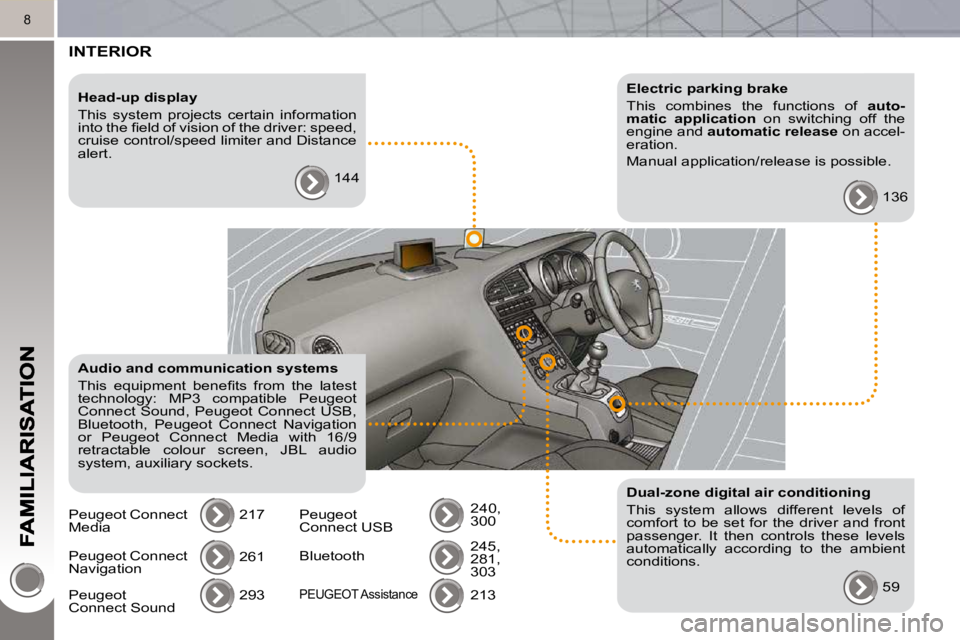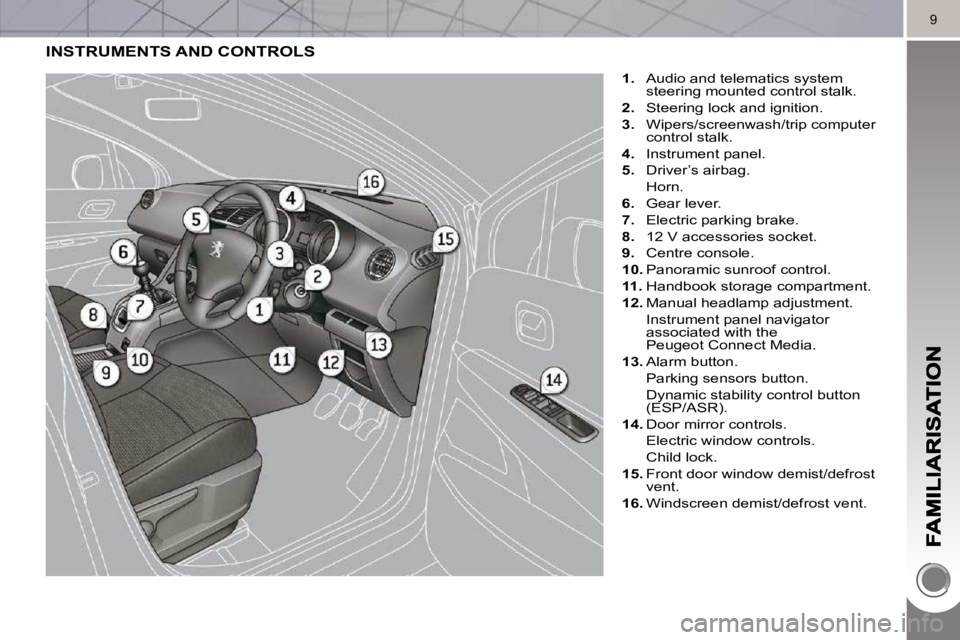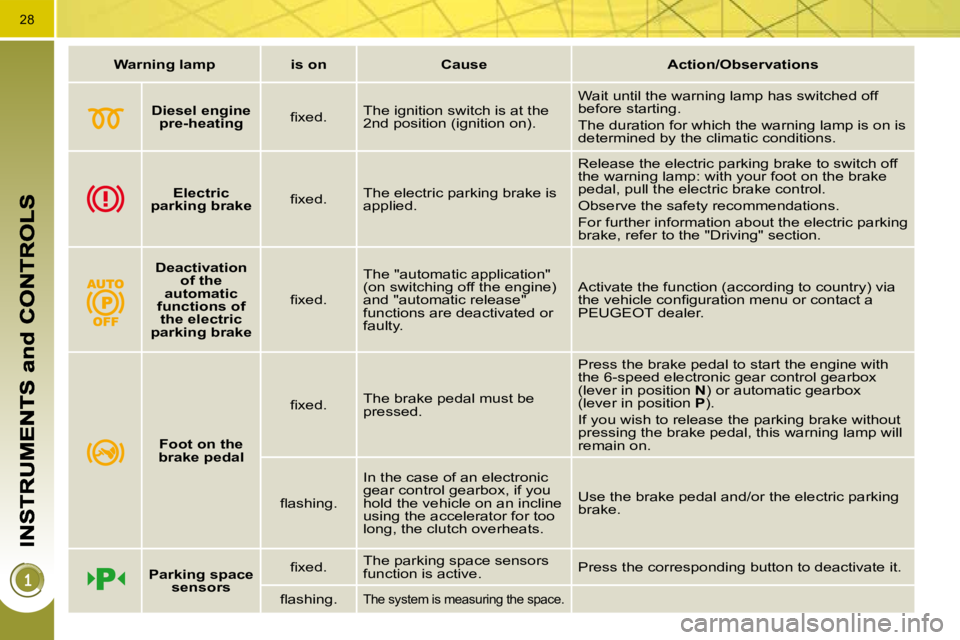parking brake PEUGEOT 5008 2010.5 Owners Manual
[x] Cancel search | Manufacturer: PEUGEOT, Model Year: 2010.5, Model line: 5008, Model: PEUGEOT 5008 2010.5Pages: 345, PDF Size: 22.77 MB
Page 5 of 345

8
INTERIOR
Electric parking brake
This combines the functions of auto-
matic application on switching off the
engine and automatic release on accel-
eration.
Manual application/release is possible.
136
Audio and communication systems
� �T�h�i�s� �e�q�u�i�p�m�e�n�t� �b�e�n�e�fi� �t�s� �f�r�o�m� �t�h�e� �l�a�t�e�s�t�
technology: MP3 compatible Peugeot
Connect Sound, Peugeot Connect USB,
Bluetooth, Peugeot Connect Navigation
or Peugeot Connect Media with 16/9
retractable colour screen, JBL audio
system, auxiliary sockets. 217 144
Dual-zone digital air conditioning
This system allows different levels of
comfort to be set for the driver and front
passenger. It then controls these levels
automatically according to the ambient
conditions. 59
Peugeot Connect
Navigation
261
293
Peugeot
Connect Sound
Peugeot Connect
Media
Peugeot
Connect USB 240,
300
Bluetooth 245,
281,
303
PEUGEOT Assistance 213
Head-up display
This system projects certain information
�i�n�t�o� �t�h�e� �fi� �e�l�d� �o�f� �v�i�s�i�o�n� �o�f� �t�h�e� �d�r�i�v�e�r�:� �s�p�e�e�d�,�
cruise control/speed limiter and Distance
alert.
Page 6 of 345

9
INSTRUMENTS AND CONTROLS
1. Audio and telematics system
steering mounted control stalk.
2. Steering lock and ignition.
3. Wipers/screenwash/trip computer
control stalk.
4. Instrument panel.
5. Driver’s airbag.
Horn.
6. Gear lever.
7. Electric parking brake.
8. 12 V accessories socket.
9. Centre console.
10. Panoramic sunroof control.
11. Handbook storage compartment.
12. Manual headlamp adjustment.
Instrument panel navigator associated with the
Peugeot Connect Media.
13. Alarm button.
Parking sensors button.
Dynamic stability control button (ESP/ASR).
14. Door mirror controls.
Electric window controls.
Child lock.
15. Front door window demist/defrost
vent.
16. Windscreen demist/defrost vent.
Page 17 of 345

20
DRIVING SAFELY
Electric parking brake
Manual application/release
The parking brake can be applied
manually by pulling the control lever A .
When the ignition is on, the parking
brake can be released manually by
pressing the brake pedal and pulling
then releasing the control lever A . Automatic application/release
Press the accelerator, press and and re-
lease the clutch (manual gearbox), the
parking brake is released automatically
and progressively on acceleration.
With the vehicle stationary, when the
engine is switched off , the parking
brake is applied automatically. Before getting out of the
vehicle, check that the
braking warning lamp
(
red! ) and the warning
lamp P , located in the control lever A
�a�r�e� �o�n� �fi� �x�e�d� �(�n�o�t� �fl� �a�s�h�i�n�g�)�.� �
136
If this warning lamp is on in
the instrument panel, the auto-
matic application/release is
de-
activated , in this case use the
manual application/release.
When the door is opened with
the engine running an audible
signal is heard, apply the park-
ing brake manually.
Do not leave a child alone in the ve-
hicle with the ignition on, they could
release the parking brake. If you are towing a trailer or a
caravan or if the gradient is like-
ly to change (transport by ship,
lorry, towing, ...), apply the park-
ing brake manually to maximum force
(long pull on control lever A ) to immo-
bilise the vehicle.
Page 23 of 345

Vehicle parameters
This menu allows you to activate or
deactivate certain driving and comfort
equipment (according to country):
- wiper linked with reverse gear (refer to the "Visibility" section),
- selective unlocking (refer to the "Access" section),
- guide-me-home and welcome light- ing (refer to the "Visibility" section),
- interior mood lighting (refer to the "Visibility" section),
- daytime running lamps (refer to the "Visibility" section),
- directional headlamps (refer to the "Visibility" section),
- automatic or manual parking brake (refer to the "Driving" section).
Choice of units
This menu allows you to select the units:
temperature (°Celsius or °Fahrenheit)
and fuel consumption (l/100 km, mpg or
km/l).
Choice of language
This menu allows you to select the
display language: Deutsch, English,
Espanol, Français, Italiano, Nederlands,
Portugues, Türkçe * .
The main menu and its asso-
ciated functions can only be
accessed when stationary, via
buttons
1 to 4 .
A message appears on the screen,
above a certain speed threshold, in-
dicating that the main menu cannot
be displayed.
The trip computer displays can only
be accessed while driving, via buttons
2 and 3 (refer to the "Trip computer"
paragraph).
Main menu
� Press button 1 for access to the
main menu and select one of the fol-
lowing functions:
- "Vehicle parameters",
- "Choice of language",
- "Choice of units".
� Press button 2 or 3 to move in the
screen.
� Press button 1� � �a�g�a�i�n� �t�o� �c�o�n�fi� �r�m� �t�h�e�
selection.
* According to country. Indicator and warning lamps
Visual indicators informing the driver
that a system is in operation (operation
or deactivation indicator lamps) or of the
occurrence of a fault (warning lamp).
When the ignition is switched on
Certain warning lamps come on for a
few seconds when the vehicle's ignition
is switched on.
When the engine is started, these same
warning lamps should switch off.
If they remain on, before moving off,
refer to the information on the warning
lamp concerned.
Associated warnings
The switching on of certain warning lamps
may be accompanied by an audible signal
and a message on the multifunction screen.
The warning lamps may come
�o�n� �c�o�n�t�i�n�u�o�u�s�l�y� �(�fi� �x�e�d�)� �o�r� �fl� �a�s�h�.�
Certain warning lamps may
come on in two different modes. Only
by relating the type of lighting to the
operating status of the vehicle can it
be ascertained whether the situation is
normal or whether a fault has occurred.
Page 24 of 345

Vehicle parameters
This menu allows you to activate or
deactivate certain driving and comfort
equipment (according to country):
- wiper linked with reverse gear (refer to the "Visibility" section),
- selective unlocking (refer to the "Access" section),
- guide-me-home and welcome light- ing (refer to the "Visibility" section),
- interior mood lighting (refer to the "Visibility" section),
- daytime running lamps (refer to the "Visibility" section),
- directional headlamps (refer to the "Visibility" section),
- automatic or manual parking brake (refer to the "Driving" section).
Choice of units
This menu allows you to select the units:
temperature (°Celsius or °Fahrenheit)
and fuel consumption (l/100 km, mpg or
km/l).
Choice of language
This menu allows you to select the
display language: Deutsch, English,
Espanol, Français, Italiano, Nederlands,
Portugues, Türkçe * .
The main menu and its asso-
ciated functions can only be
accessed when stationary, via
buttons
1 to 4 .
A message appears on the screen,
above a certain speed threshold, in-
dicating that the main menu cannot
be displayed.
The trip computer displays can only
be accessed while driving, via buttons
2 and 3 (refer to the "Trip computer"
paragraph).
Main menu
� Press button 1 for access to the
main menu and select one of the fol-
lowing functions:
- "Vehicle parameters",
- "Choice of language",
- "Choice of units".
� Press button 2 or 3 to move in the
screen.
� Press button 1� � �a�g�a�i�n� �t�o� �c�o�n�fi� �r�m� �t�h�e�
selection.
* According to country. Indicator and warning lamps
Visual indicators informing the driver
that a system is in operation (operation
or deactivation indicator lamps) or of the
occurrence of a fault (warning lamp).
When the ignition is switched on
Certain warning lamps come on for a
few seconds when the vehicle's ignition
is switched on.
When the engine is started, these same
warning lamps should switch off.
If they remain on, before moving off,
refer to the information on the warning
lamp concerned.
Associated warnings
The switching on of certain warning lamps
may be accompanied by an audible signal
and a message on the multifunction screen.
The warning lamps may come
�o�n� �c�o�n�t�i�n�u�o�u�s�l�y� �(�fi� �x�e�d�)� �o�r� �fl� �a�s�h�.�
Certain warning lamps may
come on in two different modes. Only
by relating the type of lighting to the
operating status of the vehicle can it
be ascertained whether the situation is
normal or whether a fault has occurred.
Page 26 of 345

28
Warning lamp is on Cause Action/Observations
Diesel engine
pre-heating � � �fi� �x�e�d�.� � The ignition switch is at the
2nd position (ignition on). Wait until the warning lamp has switched off
before starting.
The duration for which the warning lamp is on is
determined by the climatic conditions.
Electric
parking brake � � �fi� �x�e�d�.� � The electric parking brake is
applied. Release the electric parking brake to switch off
the warning lamp: with your foot on the brake
pedal, pull the electric brake control.
Observe the safety recommendations.
For further information about the electric parking
brake, refer to the "Driving" section.
Deactivation
of the
automatic
functions of the electric
parking brake � � �fi� �x�e�d�.� �
The "automatic application"
(on switching off the engine)
and "automatic release"
functions are deactivated or
faulty. Activate the function (according to country) via
�t�h�e� �v�e�h�i�c�l�e� �c�o�n�fi� �g�u�r�a�t�i�o�n� �m�e�n�u� �o�r� �c�o�n�t�a�c�t� �a�
PEUGEOT dealer.
Foot on the
brake pedal � � �fi� �x�e�d�.� �
The brake pedal must be
pressed. Press the brake pedal to start the engine with
the 6-speed electronic gear control gearbox
(lever in position
N ) or automatic gearbox
(lever in position P ).
If you wish to release the parking brake without
pressing the brake pedal, this warning lamp will
remain on.
� � �fl� �a�s�h�i�n�g�.� � In the case of an electronic
gear control gearbox, if you
hold the vehicle on an incline
using the accelerator for too
long, the clutch overheats. Use the brake pedal and/or the electric parking
brake.
Parking
space
sensors � � �fi� �x�e�d�.� �
The parking space sensors
function is active. Press the corresponding button to deactivate it.
� � �fl� �a�s�h�i�n�g�.� �
The system is measuring the space.
Page 29 of 345

31
Electric
parking brake � � �fl� �a�s�h�i�n�g�.� � The application or release
of the electric parking brake
was interrupted. You must stop as soon as it is safe to do so.
Park on level ground, switch off the
ignition and contact a PEUGEOT dealer
�o�r� �a� �q�u�a�l�i�fi� �e�d� �w�o�r�k�s�h�o�p�.�
+
Electric
parking brake fault � � �fi� �x�e�d�.� �
The electric parking brake
has a fault. Automatic application/release is no
longer possible.
Contact a PEUGEOT dealer or a
�q�u�a�l�i�fi� �e�d� �w�o�r�k�s�h�o�p� �w�i�t�h�o�u�t� �d�e�l�a�y�.�
The parking brake can be released
manually using the emergency release
procedure.
For more information on the electric
parking brake, refer to the "Driving"
section.
Warning lamp is on Cause Action/Observations
Braking � � �fi� �x�e�d�.� �
The braking system
�fl� �u�i�d� �l�e�v�e�l� �h�a�s� �d�r�o�p�p�e�d�
�s�i�g�n�i�fi� �c�a�n�t�l�y�.� � �T�o�p� �u�p� �w�i�t�h� �b�r�a�k�e� �fl� �u�i�d� �r�e�c�o�m�m�e�n�d�e�d� �b�y�
PEUGEOT.
If the problem persists, have the system
checked by a PEUGEOT dealer.
+ � � �fi� �x�e�d�,� �a�s�s�o�c�i�a�t�e�d� �w�i�t�h�
the electric parking
brake fault warning lamp, if the parking brake is released. The braking system has a
fault.
Stop as soon as it is safe to do so.
Park, switch off the ignition and contact
a PEUGEOT dealer.
+ � � �fi� �x�e�d�,� �a�s�s�o�c�i�a�t�e�d�
with the ABS warning lamp. The electronic brake force
distribution (EBFD) system
has a fault.
Have it checked by a PEUGEOT dealer.
Anti-lock
Braking System (ABS) � � �fi� �x�e�d�.� �
The anti-lock braking system
has a fault. The vehicle retains conventional braking.
Drive carefully at reduced speed and
contact a PEUGEOT dealer without delay.
Page 39 of 345

40
� � �V�e�h�i�c�l�e� �c�o�n�fi� �g�u�r�a�t�i�o�n� Options
Once the "Options" menu has been se-
lected, you can start diagnostics of the
status of the equipment (active, not active,
faulty).
Languages
Once the "Languages" menu has been
selected, you can change the language
used by the display (Français, Italiano,
Nederlands, Portugues, Portugues-Brasil,
Türkçe, Deutsch, English, Espanol).
Display settings
Once the "Display settings" menu has
been selected, you can gain access to
the following settings:
- year,
- month,
- day,
- hour,
- minutes,
- 12 or 24 hour mode. Units
Once the "Units" menu has been selected,
you can change the units for:
- temperature (°C or °F),
- fuel consumption (l/100 km, mpg or
km/l).
� Once you have selected a setting,
press the "OK" button to change its
value.
� Wait for approximately ten sec-
onds without any action to allow the
changed data to be recorded or press
the "ESC" button to cancel.
The screen then returns to the normal
display.
� �O�n�c�e� �t�h�e� �"�V�e�h�i�c�l�e� �c�o�n�fi� �g�u�r�a�t�i�o�n�"� �m�e�n�u�
has been selected, you can activate or
deactivate the following equipment (ac-
cording to country):
- wiper linked with reverse gear (refer to the "Visibility" section),
- selective unlocking (refer to the "Access" section),
-
"guide-me-home" and welcome lighting
(refer to the "Visibility" section),
- interior mood lighting (refer to the "Visibility" section),
- daytime running lamps (refer to the "Visibility" section),
- directional headlamps (refer to the "Visibility" section),
- automatic or manual parking brake (refer to the "Driving" section),
- ... � � �F�o�r� �s�a�f�e�t�y� �r�e�a�s�o�n�s�,� �c�o�n�fi� �g�u�-
ration of the multifunction
screen by the driver must only
be done when stationary.
Page 41 of 345

42
� � �F�o�r� �s�a�f�e�t�y� �r�e�a�s�o�n�s�,� �c�o�n�fi� �g�u�-
ration of the multifunction
screen by the driver must only
be done when stationary.
Display settings
Once the "Display settings" menu has
been selected, you can gain access to
the following settings:
- year,
- month,
- day,
- hour,
- minutes,
- 12 or 24 hour mode.
Languages
Once the "Languages" menu has been
selected, you can change the language
used by the display (Français, Italiano,
Nederlands, Portugues, Portugues-Brasil,
Türkçe, Deutsch, English, Espanol).
Units
Once the "Units" menu has been se-
lected, you can change the units of the
following parameters:
- temperature (°C or °F),
- fuel consumption (l/100 km, mpg
or km/l).
� Once you have selected a setting,
press the " � " or " � " buttons to
change its value.
� Press the " � " or " � " buttons to
switch respectively to the previous
or next setting.
� Press the "OK" button to record
the change and return to the normal
display or press the "ESC" button to
cancel.
� � �V�e�h�i�c�l�e� �c�o�n�fi� �g�u�r�a�t�i�o�n�
� �O�n�c�e� �t�h�e� �"�V�e�h�i�c�l�e� �C�o�n�fi� �g�u�r�a�t�i�o�n�"� �m�e�n�u�
has been selected, you can activate or
deactivate the following equipment (ac-
cording to country):
- wiper linked with reverse gear (refer
to the "Visibility" section),
- selective unlocking (refer to the "Access" section),
- guide-me-home and welcome light- ing (refer to the "Visibility" section),
- interior mood lighting (refer to the "Visibility" section),
- daytime running lamps (refer to the "Visibility" section),
- directional headlamps (refer to the "Visibility" section),
- automatic or manual parking brake (refer to the "Driving" section),
- ...
Options
Once the "Options" menu has been se-
lected, you can start diagnostics of the
status of the equipment (active, not active,
faulty).
Page 43 of 345

44
"Trip computer" menu
� Press the "MENU" button to gain
access to the general menu.
� Press the arrows, then the "OK" but-
ton to select the "Trip computer"
menu.
� On the "Trip computer" menu,
select one of the following applica-
tions:
Alert log
This summarises the active warning
messages, displaying them in succes-
sion in the multifunction screen.
Once this menu has been selected, you
can consult information concerning the
status of the vehicle (alert log, status of
the functions...).
� � �D�e�fi� �n�e� �t�h�e� �v�e�h�i�c�l�e� �p�a�r�a�m�e�t�e�r�s�
Once this menu has been selected, you
can activate or deactivate the following
equipment (according to country):
- wiper linked with reverse gear (refer
to the "Visibility" section),
- selective unlocking (refer to the "Access" section),
- guide-me-home lighting (refer to the "Visibility" section),
- interior mood lighting (refer to the "Visibility" section),
- daytime running lamps (refer to the "Visibility" section),
- directional headlamps (refer to the "Visibility" section),
- automatic or manual parking brake (refer to the "Driving" section),
- ... "Personalisation-Configuration" menu
Once this menu has been selected, you
can gain access to the following func-
tions:
� � � �-� � �d�e�fi� �n�e� �t�h�e� �v�e�h�i�c�l�e� �p�a�r�a�m�e�t�e�r�s�,�
� � �-� � �d�i�s�p�l�a�y� �c�o�n�fi� �g�u�r�a�t�i�o�n�,�
- choice of language.
Status of functions
This summarises the active or inactive
status of the functions present on the
vehicle.
Enter the distance to the destination
This allows you to enter an approximate
�v�a�l�u�e� �f�o�r� �t�h�e� �d�i�s�t�a�n�c�e� �t�o� �t�h�e� �fi� �n�a�l� �d�e�s�t�i�-
nation.